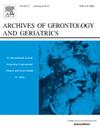Effects of Otago Exercise Program and aquatic exercise on fall risk in older adults: A systematic review
IF 3.5
3区 医学
Q2 GERIATRICS & GERONTOLOGY
引用次数: 0
Abstract
Background
The aim of this systematic review was to determine the processes and forms of participation in Otago Exercise Program (OEP) and Aquatic exercise(AE) for the prevention of falls in older adults, and to compare the effectiveness of the two exercises as interventions for the prevention of falls in older adults.
Methods
Using electronic databases such as PubMed, Web of Science, Embase, Scopus, and Google Scholar, we searched for relevant domestic and foreign papers in the last 15 years, and evaluated the methodology and quality of the report by both AMSTAR 2 and PRISMA scales to evaluate the methodology and reporting quality.
Results
A total of 33 papers were included by searching various literatures related to the topic of this study and carefully reviewed by the researcher.
Conclusion
This systematic review confirms that OEP and AE effectively prevent falls in older adults by improving cognitive function, lower limb muscle strength, and balance. OEP significantly enhances muscle strength, while AE shows slight superiority in improving balance-related abilities like gait stability. These findings highlight the need for optimized training cycles in OEP and AE to maximize muscle adaptation. Both programs are safe and effective, with potential to reduce falls and enhance physical and cognitive functions. Tailored interventions, aligned with home health care guidelines and specific living environments, can improve quality of life. Future research should explore the optimal exercise modalities and intensities, and conduct longitudinal studies to assess long-term outcomes, particularly for older adults with specific health conditions.
奥塔哥运动计划和水上运动对老年人跌倒风险的影响:一项系统综述
本系统综述的目的是确定奥塔哥运动计划(OEP)和水上运动(AE)预防老年人跌倒的参与过程和形式,并比较这两种运动作为预防老年人跌倒的干预措施的有效性。方法利用PubMed、Web of Science、Embase、Scopus、b谷歌Scholar等电子数据库,检索近15年来国内外相关论文,采用AMSTAR 2和PRISMA量表对报告的方法学和报告质量进行评价。结果通过检索与本研究主题相关的各种文献,并经研究者仔细审阅,共纳入论文33篇。结论本系统综述证实,OEP和AE通过改善认知功能、下肢肌肉力量和平衡,有效预防老年人跌倒。OEP能显著增强肌肉力量,而AE在改善步态稳定性等平衡能力方面略有优势。这些发现强调了优化OEP和AE训练周期以最大化肌肉适应的必要性。这两个项目都是安全有效的,有可能减少跌倒,增强身体和认知功能。量身定制的干预措施,与家庭保健指南和特定的生活环境相一致,可以改善生活质量。未来的研究应该探索最佳的运动方式和强度,并进行纵向研究以评估长期结果,特别是对有特殊健康状况的老年人。
本文章由计算机程序翻译,如有差异,请以英文原文为准。
求助全文
约1分钟内获得全文
求助全文
来源期刊
CiteScore
7.30
自引率
5.00%
发文量
198
审稿时长
16 days
期刊介绍:
Archives of Gerontology and Geriatrics provides a medium for the publication of papers from the fields of experimental gerontology and clinical and social geriatrics. The principal aim of the journal is to facilitate the exchange of information between specialists in these three fields of gerontological research. Experimental papers dealing with the basic mechanisms of aging at molecular, cellular, tissue or organ levels will be published.
Clinical papers will be accepted if they provide sufficiently new information or are of fundamental importance for the knowledge of human aging. Purely descriptive clinical papers will be accepted only if the results permit further interpretation. Papers dealing with anti-aging pharmacological preparations in humans are welcome. Papers on the social aspects of geriatrics will be accepted if they are of general interest regarding the epidemiology of aging and the efficiency and working methods of the social organizations for the health care of the elderly.

 求助内容:
求助内容: 应助结果提醒方式:
应助结果提醒方式:


